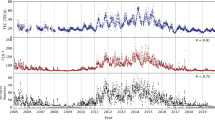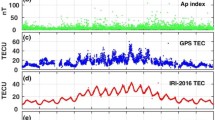Abstract
This paper investigates the performance of International Reference Ionosphere (IRI-2016) in predicting the variation of the Total Electron Content (TEC) over six IGS stations in the mid-latitude region. Three of the stations are in the northern hemisphere and three in the southern hemisphere. IRI-2016 TEC values are estimated using various Ne Topside, Ne F-peak and F-peak height options during different geomagnetic and solar activity conditions. Three different ionospheric conditions are considered; geomagnetic active-solar quiet days (June 23, 2015; October 7, 2015), geomagnetic-solar quiet days (May 23, 2015; July 19, 2015) and geomagnetic quiet-solar active days (July 8, 2014; December 18, 2014). Model derived TEC values are compared with the GPS-TEC data, which is used as a reference value. The overall results show that TEC predictions using IRI-2001 (Ne-Topside) and URSI (Ne F-peak) options provide better agreement with GPS-TEC values for the summer days. Whereas IRI01-corr—NeQuick (Ne-Topside) with CCIR (Ne F-peak) options predict well for the winter days. Besides, evaluation of the results reveals insignificant differences (<1 TECU) among three F-peak height option (AMTB-2013, SHU-2015 and BSE-1979) solutions. Furthermore, regardless of which IRI parameter is used during active days, the differences between IRI-TEC and GPS-TEC reach high values at some stations at some time intervals.
















Similar content being viewed by others
REFERENCES
Acharya, R. and Majumdar, S., Comparison of observed ionospheric vertical TEC over the sea in Indian region with IRI-2016 model, Adv. Space Res., 2019, vol. 63, no. 6, pp. 1892–1904. https://doi.org/10.1016/j.asr.2018.10.049
Alcay, S., Yigit, C.O., Seemala, G., and Ceylan, A., GPS-based ionosphere modeling: A brief review, Fresenius Environ. Bull., 2014, vol. 23, no. 3a, pp. 815–824.
Alcay, S., Oztan, G., and Selvi, H.Z., Comparison of IRI_PLAS and IRI_2012 model predictions with GPS_TEC measurements in different latitude regions, Ann. Geophys., 2017, vol. 60, no. 5. https://doi.org/10.4401/ag-7311
Arikan, F., Erol, C.B., and Arikan, O., Regularized estimation of vertical total electron content from Global Positioning System data, J. Geophys. Res., 2003, vol. 108, no. A12, 1469. https://doi.org/10.1029/2002JA009605
Arikan, F., Erol, C.B., and Arikan, O., Regularized estimation of vertical total electron content from GPS data for a desired time period, Radio Sci., 2004, vol. 39, no. RS6012. https://doi.org/10.1029/2004RS003061
Bilitza, D., IRI the international standard for the ionosphere, Adv. Radio Sci., 2018, vol. 16, pp. 1–11. https://doi.org/10.5194/ars-16-1-2018
Bilitza, D., Altadill, D., Truhlik, V., Shubin, V., Galkin, I., Reinisch, B., and Huang, X., International Reference Ionosphere 2016: From ionospheric climate to real-time weather predictions, Space Weather, 2017, vol. 15, pp. 418–429. https://doi.org/10.1002/2016SW001593
Cherniak, I. and Zakharenkova, I., Evaluation of the IRI-2016 and NeQuick electron content specification by COSMIC GPS radio occultation, ground-based GPS and Jason-2 joint altimeter/GPS observations, Adv. Space Res., 2019, vol. 63, no. 6, pp. 1845–1859. https://doi.org/10.1016/j.asr.2018.10.036
Mengistua, E., Damtie, B., Moldwin, M.B., and Nigussie, M., Comparison of GPS-TEC measurements with NeQuick2 and IRI model predictions in the low latitude East African region during varying solar activity period (1998 and 2008–2015), Adv. Space Res., 2018, vol. 61, no. 6, pp. 1456–1475. https://doi.org/10.1016/j.asr.2018.01.009
Nayir, H., Arikan, F., Arikan, O., and Erol, C.B., Total electron content estimation with Reg-Est, J. Geophys. Res.: Space Phys., 2007, vol. 112, no. A11. https://doi.org/10.1029/2007JA012459
Nohutcu, M., Karslioglu, M.O., and Schmidt, M., B-Spline modeling of VTEC over Turkey using GPS observations, J. Atmos. Sol.-Terr. Phys., 2010, vol. 72, nos. 7–8, pp. 617–624. https://doi.org/10.1016/j.jastp.2010.02.022
Patel, N.C., Karia, S.P., and Pathak, K.N., Evaluation of the improvement of IRI-2016 over IRI-2012 at the India low-latitude region during the ascending phase of cycle 24, Adv. Space Res., 2019, vol. 63, no. 6, pp. 1860–1881. https://doi.org/10.1016/j.asr.2018.10.008
Pignalberi, A., Pezzopane, M., Tozzi, R., Michelis, P.D., and Coco, I., Comparison between IRI and preliminary Swarm Langmuir probe measurements during the St. Patrick storm period, Earth, Planets Space, 2016, vol. 68, no. 93. https://doi.org/10.1186/s40623-016-0466-5
Sharma, S.K., Ansari, K., and Panda, S.K., Analysis of ionospheric TEC variation over Manama, Bahrain, and comparison with IRI-2012 and IRI-2016 models, Arabian J. Sci. Eng., 2018, vol. 43, pp. 3823–3830. https://doi.org/10.1007/s13369-018-3128-z
Shi, C., Zhang, T., Wang, C., Wang, Z., and Fan, L., Comparison of IRI-2016 model with IGS VTEC maps during low and high solar activity period, Results Phys., 2019, vol. 12, pp. 555–561. https://doi.org/10.1016/j.rinp.2018.12.022
Tariku, Y.A., Testing the improvement of performance of the IRI model in the estimation of TEC over the mid-latitude American regions, Adv. Space Res., 2019a, vol. 63, no. 7, pp. 2066–2074. https://doi.org/10.1016/j.asr.2018.12.009
Tariku, Y.A., Assessment of improvement of the IRI model over Ethiopia for the modeling of the variability of TEC during the period 2013–2016, Adv. Space Res., 2019b, vol. 63, no. 5, pp. 1634–1645. https://doi.org/10.1016/j.asr.2018.11.014
ACKNOWLEDGMENTS
The author would like to express his gratitude to the IRI working group for providing IRI_2016 model. The author thanks the IONOLAB group for providing ionolabtecv1.30 software.
Author information
Authors and Affiliations
Corresponding author
Rights and permissions
About this article
Cite this article
Salih Alcay Analysis of the TEC Prediction Performance of IRI-2016 Model in the Mid-Latitude Region. Geomagn. Aeron. 61, 600–618 (2021). https://doi.org/10.1134/S0016793221040149
Received:
Revised:
Accepted:
Published:
Issue Date:
DOI: https://doi.org/10.1134/S0016793221040149




